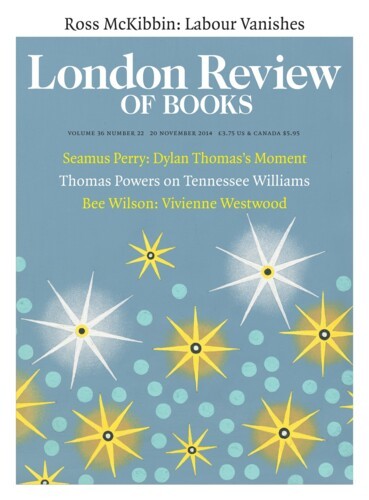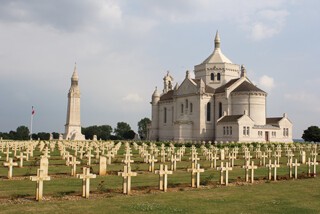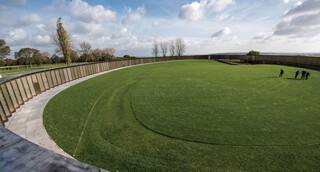The French national necropolis of Notre Dame de Lorette lies on a plateau to the north of Arras where a pilgrims’ chapel once stood. The bodies of some forty thousand French soldiers who died in the Great War were buried here in the 1920s: half of them, unidentified, in mass graves; the other half beneath long lines of concrete crosses, each with a small metal label to give a name. This is the sort of cemetery that film-makers like to use, so the camera can pan over a vast sea of crosses, stretching towards infinity – an image which the smaller but more numerous British cemeteries with their rows of white headstones (never crosses) cannot provide.
In the centre stands a large basilica and, close by, a tall lantern tower. Both were the work of Louis-Marie Cordonnier who, in prewar days, had designed the Palace of Peace at The Hague. The basilica is vaguely Romanesque in style and reminiscent of the vast and dreary basilica at Lisieux for which he was also responsible. Cordonnier’s basilica of Notre Dame de Lorette could have been produced decades earlier. He was an old man, born in 1854, and, unlike the architects of the strange and terrifying ossuary in the national necropolis at Douaumont near Verdun, he made little attempt to find a contemporary language to convey the horror of industrialised warfare and mass death. Nor did he exploit the resonances of the classical tradition as Lutyens, Blomfield and the other British architects of the Imperial War Graves Commission did. On the other hand, you could say that Cordonnier’s basilica accurately conveys the state of a nation exhausted and traumatised by four years of war on its soil.
This part of France saw repeated bouts of heavy fighting. As a result, there is Lutyens’s Memorial to the Missing at Arras and the area is dotted with British war cemeteries; the astonishing, expressionist Canadian Memorial at Vimy Ridge is not far away, and then there is the huge German cemetery at Neuville-St Vaast in which 45,000 men of the Kaiser’s armies are buried. And now, a century after the outbreak of war, another memorial has been built on the plateau, next to the necropolis. Commissioned by the Nord-Pas de Calais region and the French Ministry of Defence and designed by the Paris architect Philippe Prost, it provides a new answer to the problem of creating an expressive architectural memorial once the classical language is abandoned. This International Memorial is a huge open elliptical ring, 129 metres long and 75 wide, constructed of steel fibre, and it succeeds in being monumental without sentimentality or, more important, triumphalism. The axis of the ellipse diverges from the rigid geometry of the older cemetery, and part of it, by a brilliant feat of engineering, is suspended over falling ground ‘in order to symbolise the fragile nature of peace’. Its purpose is revealed on the promenade on the inner side of the ring, almost a quarter of a mile long, where, on angled panels like the pages of books, are inscribed the names of some 580,000 men who died in this part of France between 1914 and 1918.
Are there not enough war memorials already? In Britain, there is one in every town, every village, every church. Every military casualty of the Great War either has a headstone in one of the cemeteries in France, Belgium or further afield, lovingly maintained by the Commonwealth War Graves Commission, or has his name carved on one of the sublime Memorials to the Missing. And yet today we are building more and more war memorials, of dubious aesthetic merit, most of them gratuitously concerned with the Second World War and so helping to sustain the self-justifying national myth: Women of the Second World War, Animals in War, Bomber Command etc. Then there is the Armed Forces Memorial in the National Memorial Arboretum in Staffordshire, unveiled in 2007: an impressive circular structure in which a diluted version of the classical manner so well developed by the architects of the IWGC in the 1920s is combined with the sort of sentimental figurative sculpture they were rightly anxious to avoid.
There is, however, an important difference between these British memorials and the shiny metallic structure inaugurated by François Hollande. The International Memorial is just that: the 580,000 names of young men who died in Artois and French Flanders in the Great War include everyone, listed in alphabetical order – French, German, Canadian, Indian, Australian, British, Czechs, Slovaks and others – regardless of nationality. In comparison, the British response to the centenary so far has been depressingly insular. There is the current, very popular installation of 888,246 ceramic poppies in the moat of the Tower of London, each of which represents a ‘British fatality’. But this is the figure of the UK dead and so ignores not least the many from India, New Zealand, South Africa and other parts of the empire, whose men were enlisted in the struggle by Britain.
I wouldn’t go as far as Jonathan Jones in the Guardian, who called the poppy installation ‘a Ukip style memorial’. But he has a point. I wonder whether next year we will remember that we wouldn’t have ‘won’ the Battle of Waterloo without General Blücher and his Prussians. The recent books by Christopher Clark and Margaret Macmillan, which suggest that the catastrophe of 1914 was caused, in part, by secret treaties, devious and incompetent diplomacy and a culture of militarism from which Britain can’t be exculpated, have had little impact on public attitudes. The need to see this country as always in the right now even extends to rehabilitating the dreadful Douglas Haig – how many know that the commander-in-chief who orchestrated the Allied victory on the Western Front in 1918 was in fact French: Ferdinand Foch?
In this context, the International Memorial at Notre Dame de Lorette is refreshingly sane and eirenic. And this despite the fact that France had many more casualties – almost 1.4 million – than the British Empire and that a whole swathe of French territory was devastated by the war, with 460 square miles of it, the Zone Rouge, regarded as too damaged ever to be used again for habitation or farming.
Send Letters To:
The Editor
London Review of Books,
28 Little Russell Street
London, WC1A 2HN
letters@lrb.co.uk
Please include name, address, and a telephone number.



